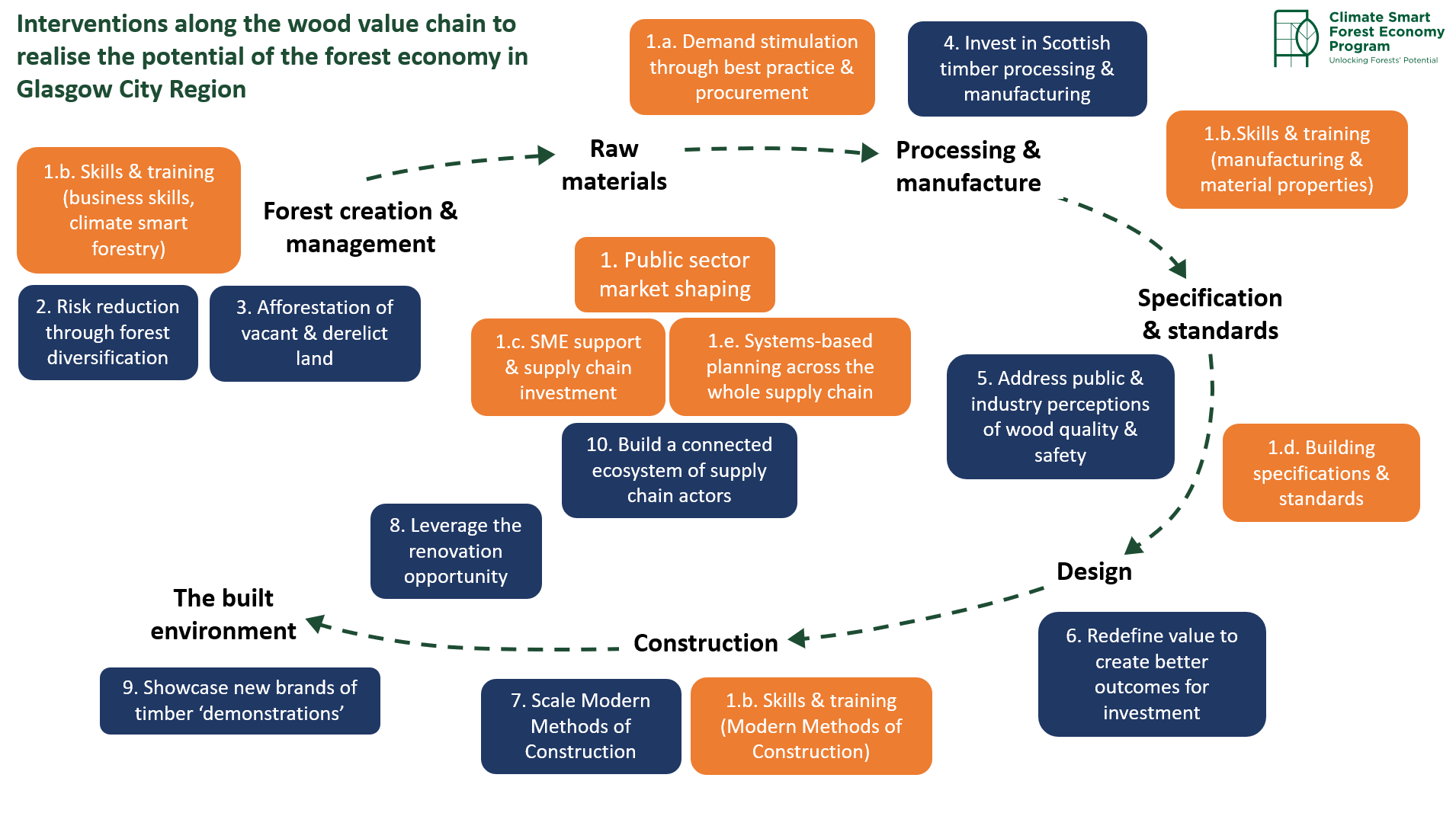Glasgow City Region pioneering forest economy innovation to drive climate action

Scotland’s largest city region is actively tackling climate change through a range of resilience and adaptation measures, such as the Glasgow Green Deal, the Clyde Climate Forest and Climate Ready Clyde. These activities are now being reinforced by another innovative project. Glasgow City Region has recently launched a regional initiative under the Climate Smart Forest Economy Programme, an ambitious example of innovation in forests and forest products, to reshape and restructure operations in the region’s forestry, built environment, construction and manufacturing sectors.
The Climate Smart Forest Economy Programme (CSFEP) is a joint initiative of Climate KIC, the World Economic Forum, and the World Resources Institute, with seed funding from the Good Energies Foundation. It also counts on an independent scientific council from The Nature Conservancy, and support from Dalberg Catalyst. Its overarching goal is to unlock the full climate potential of forests and forest products in a sustainable and responsible manner. The program aims to increase the use of climate smart forest products by catalysing market demand in sectors that need rapid decarbonisation (such as construction) while meeting social and ecological safeguards. “Ensuring all forest economies are climate smart can protect, maintain, manage, restore, and regrow forests, while assigning greater value to forests, creating further incentives for restoration and reforestation”.
An ambitious plan for the Glasgow City Region
The Glasgow City Region (GCR) covers a third of Scotland, both by population and economic output. Glasgow City Council has committed to becoming carbon neutral and climate resilient by 2030, working in partnership across the entire region. To achieve this, Glasgow has launched the “Glasgow Green Deal”, which sets a new direction that combines economic prosperity and jobs with the actions needed to tackle the climate crisis. It seeks to rewire economic, social and political systems and institutions to design out carbon emissions and climate vulnerability, and design in strong social foundations, equity and fairness. Building on the ambitions of the Glasgow Green Deal, the eight local authorities in the GCR have also committed to a common Economic Strategy to promote regional competitiveness and inclusive growth.
At the national level, Scotland has set ambitious targets for woodland creation, recognising the important role forests play in tackling climate change. Locally, in the Glasgow City Region, the Clyde Climate Forest has pledged to plant ten trees for every inhabitant over the next decade (18 million trees). However, at both the national and regional levels, woodland creation has largely been framed as a carbon sink opportunity rather than a way to promote carbon storage in forest products or the substitution of high carbon footprint materials with wood-based products. Woodland creation remains largely detached from the fuller wood value chain.
Transformative vision setting and intent
As part of the Climate Smart Forest Economy Programme, Climate KIC is working with the Glasgow City Region to develop a holistic approach to unlocking the full climate and economic potential of forests, forest production and wood value chains.
One of the first steps in the transformation process was a visioning exercise. Visioning is about imagining the desirable future and describing what it might look like. This imaginative exercise is essential to plan the future. A vision is not a daydream in which an ideal but unrealistic and impossible future is described. Instead, a vision should be credible, practical, and feasible enough to be useful, to set direction and generate a buy-in to achieve it. At the same time, a vision should be based on a radical idea to guide actions and decisions in a transformative direction.
Participants of the visioning exercise were asked: what kind of a Climate-Smart Forest Economy (CSFE) do we want for GCR and what is required to achieve it? Participants were encouraged to look at the world as a complex system, and to develop a set of interventions that together would shift the system to a more desirable state. The vision statement below outlines what that vision would look like for Glasgow City Region. It clearly reflects the regional context, priorities, and opportunities that a CSFE could bring:
“A GCR Climate Smart Forest Economy (CSFE) would make use of the Scottish timber technologies sector by manufacturing products sourced from sustainably managed ‘home-grown’ forests and imported timber for domestic and export use. It would make a significant long-term contribution to the mission of the Glasgow Green Deal to create equitable, net zero carbon, climate-resilient living by 2030 by increasing carbon sequestration, storage, and substitution through timber. In line with the City Region’s new Economic Strategy, the CSFE would enhance productivity and green recovery by creating and investing in rural and urban low carbon jobs and enterprises, urban regeneration, and significantly strengthens and diversifies the region’s timber-based manufacturing industry.”
Quantifying the carbon and economic potential of the CSFE
Local authorities are responsible for a range of local development objectives (from community health and wellbeing to net-zero emissions and climate adaptation to skills and jobs). The pace of change that society must go through can be challenging and requires long-term and intergenerational thinking. Most local governments aren’t well equipped to handle this as well as the immediate local concerns.
Mapping and quantifying the whole of the CSFE’s potential (ecological, social, and economic impacts) allows local authorities to place it alongside other policy priorities. It also demonstrates the range of complimentary benefits that could be realised through the full value chain transformation envisioned by a CSFE. A baseline (i.e., the situation as it is now) first needs to be set in order to assess the potential impacts of alternative future scenarios.
In the GCR, carbon potential was quantified by modelling the carbon sequestration impacts of existing and projected forest cover at three different scales: GCR, the Central Belt, and Scotland as a whole. The work also modelled the carbon footprint of construction materials to estimate the potential for production at each of the three spatial scales, using cross-laminated timber (CLT) as an example. This involved estimating the carbon footprint (i.e., savings) that could be achieved by substituting products in the building sector and demonstrating the additional carbon benefit of using the new woodland area beyond passive carbon sequestration.
The impacts were also compared to the economic and social policy priorities of the Green Deal, specifically, ensuring a fairer and more equal economy, supporting regeneration, improving infrastructure performance and reliability, improving economic and business competitiveness, increasing inward investment, and creating jobs.
Co-designing a portfolio of value chain interventions
A shift from single-point solutions to portfolios of interventions is essential to unlock the transformation outlined in the vision. The systemic transformation is only feasible with a portfolio of integrated and coordinated interventions working along whole value chains. Local authorities are well placed to drive the development of this portfolio, as they interact at various points along the entire wood value chain, as well as having overall responsibility for area-based emissions reduction, adaptation and economic development.
Identifying this set of interventions first requires us to understand the system in question (in this case, the wood value chain) and the full spectrum of challenges and opportunities at play. There are several actors along the wood value chain, from forest managers, sawmill processers, building contractors, to housing developers and landowners. Each of these stakeholders brings a unique perspective on how the current system works, and the barriers to transformation
To co-design the portfolio of value chain interventions, the Glasgow City Region conducted a mapping exercise to identify organisations across the value chain. This mapping built on an existing system mapping of wood in construction in Scotland[1] developed as part of the Landscapes as Carbon Sinks project, and mapped value chain actors against the core systems challenges already identified by the Centre for Sustainable Forests and Landscapes at the University of Edinburgh. Over 35 value chain actors were then engaged in a co-design process (a workshop and a series of one-on-one discussions) to identify the interventions that have the potential to address these systems challenges and collectively transform the wood value chain.
This helped to identify a series of approximately 10 interventions (see diagram below), such as increasing forest diversity to reduce risk, addressing public and industry perceptions of wood quality and safety, rethinking public procurement to create market demand, and scaling innovation in construction. What became apparent is that the public sector’s market-shaping interventions (in orange) extend to almost all aspects of the value chain, for instance through the provision of skills training, standards, and investment.
Moving from systems thinking to systems action
Understanding the system is one thing, but addressing the climate emergency, and delivering transformation, in time (i.e., mobilising the scale of investment, innovation and stakeholder support) requires further action. Although more organisations and funders are engaging with and advocating for systems thinking, the challenge of systems action remains.
Climate KIC and the Glasgow City Region applied systems thinking to identify a pathway to transform the wood value chain to maximise the role of forests in meeting the region net-zero ambitions, whilst supporting jobs and businesses. Together, they identified five market-shaping public sector activities through applied systems thinking processes:
- Stimulating demand through best practises and procurement.
- Skills development and training along the supply chain.
- Support of SME’s and supply chain investment
- Building specifications and standards
- System-based planning across the entire supply chain
During the next stage of the project this year, the stakeholders will work together on creating a supportive, sustainable market for promoting a local CSFE. A particular focus will be on creating an enabling environment for increased investment along the value chain (e.g., funding opportunities and governance structures for the interventions) and continuing to bring together value chain actors to form alliances to implement these interventions. The continued reinforcement of the region’s support and direction in shaping a local CSFE is at the core of the project.
- [1] Ghazoul, J., Toteva, G., 2021. Systems approach to the challenges and opportunities for a wood-based construction sector: A Scotland case study. Manuscript submitted for publication

